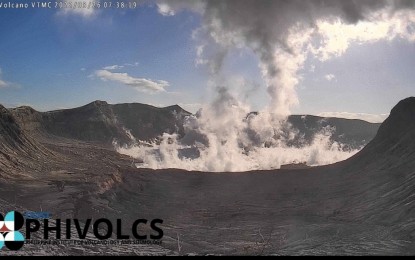
TAAL ERUPTION. Screengrab from footage of the phreatomagmatic eruption of the Taal Main Crater on Saturday morning (March 26, 2022). The eruption produced steam-laden grayish plumes that rose 3 kilometers and were accompanied by volcanic earthquakes and infrasound. (Photo courtesy of Phivolcs)
MANILA — Sulfur-smelling wet ashfall was reported in Taal Volcano and along a number of its surrounding shores in Batangas, the Philippine Institute of Volcanology and Seismology (Phivolcs) said Saturday night.
"Sulfur-smelling wet ashfall was reported on Taal Volcano Island or TVI along the Calauit [in Balete] and Alas-as [in San Nicolas] shorelines and on the lakeshore of Banyaga, Agoncillo, Batangas," said Phivolcs in its eruption update.
This ashfall, the Department of Health (DOH) said in a separate advisory, may cause eye irritation, cough, bronchitis-like illness, discomfort while breathing, nose and throat irritation. It may also cause injuries due to roof collapse or vehicular accidents caused by slippery roads and poor visibility.
The DOH said those with asthma, emphysema, and bronchitis should avoid exposure to volcanic ash — the powder-sized particles that have been blown into the air by an erupting volcano.
The DOH likewise urged the affected individuals to minimize exposure to ashfall and stay indoors as much as possible. The use of N95 mask, goggles, or eyeglasses was also encouraged.
Phivolcs on Saturday raised the alert level status of the Taal Volcano, from Level 2 (increasing unrest) to Level 3 (magmatic unrest), following phreatomagmatic bursts recorded between 7:22 a.m. and 8:59 a.m. This generated plumes up to 3,000 meters high.
Phreatomagmatic eruptions are caused by the interaction of magma and water. Eruptions normally consist of multiple explosive events, the interval of which may vary.
"The activity was recorded by 11 of 16 seismic stations of the Taal Volcano Network as volcanic tremor events that lasted 5 and 86 minutes, and as many as 66 discrete explosions were detected by five of seven infrasound stations," Phivolcs said in the advisory.
There has been no further activity since the eruption ceased, it added.
Three low-frequency volcanic earthquakes and five volcanic tremor events that lasted two to three minutes for the subsequent observation period have so far been recorded.
Volcanic earthquakes are said to be caused by movements or eruptions of magma from the volcano.
Under Alert Level 3, there is magmatic intrusion at the main crater that may further drive succeeding eruptions.
Phivolcs director Renato Solidum earlier said this refers to the rise of magma into shallower levels of the volcano, which can cause further explosions as the magma can explode because of gases inside it or when the magma interacts with groundwater in the shallower levels of the volcano.
Phivolcs earlier suggested that those in the TVI and high-risk barangays of Bilibinwang and Banyaga in Agoncillo town, as well as Buso-Buso, Gulod, and eastern Bugaan East in Laurel town in Batangas be evacuated due to the possible hazards of pyroclastic density currents and volcanic tsunami should stronger eruptions subsequently occur.
Entry into TVI as well as high-risk barangays of Agoncillo and Laurel must be prohibited, and all activities on Taal Lake should not be allowed, Phivolcs added. (PNA)
